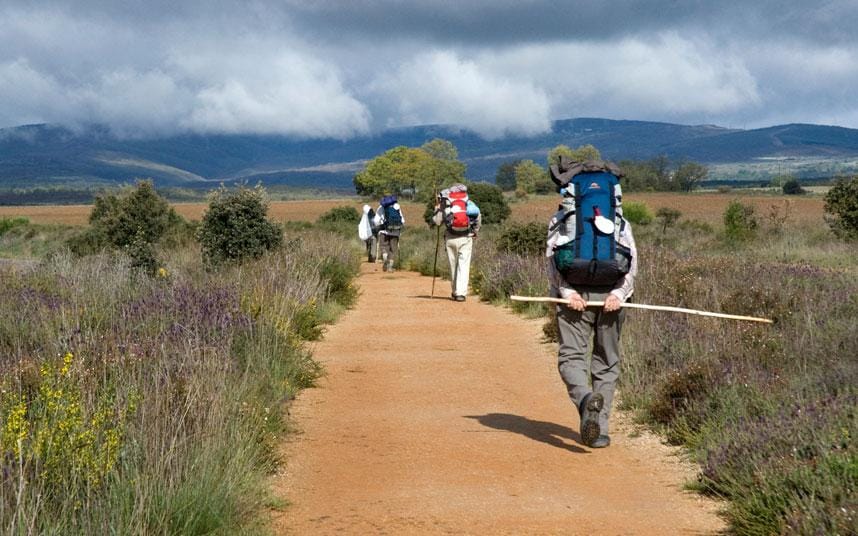
On Easter Sunday this year, I accidentally signed up for a fifty-day pilgrimage to the Holy Land. Before the pandemic, (and presumably after the pandemic) pilgrimages to various locations have been experiencing a world-wide surge in interest. The spiritual practice of the wayfarer’s journey is ancient, and ubiquitous in every religious tradition including the unthematic spirituality of secular participants. Judaism has always directed her pilgrims to a variety of sacred sites in Jerusalem. Islam has its famous Hajj to Mecca. Buddhism attracts followers to Siddhartha Gautama’s birthplaces (both physical and spiritual). Hinduism has way too many sites to mention. Various American native tribes have their equivalents of Mount Sinai (e.g. The Cheyenne’s Bear Butte). Recently, athletically inclined Christians have been beating a path to the Camino de Santiago in Spain. Cheryl Strayed’s bestseller, Wild (2012) described her own sacred journey of healing and transcendence along the Pacific Coast Trail. Many who would never cross the threshold of a church, synagogue or temple have found sanctification in mountain cathedrals, forest trails, and remote waterways. For the pilgrim, it’s not just the destination that matters, it’s the process of getting there. By carving out the time, and traversing the space, the wayfarer inevitably ends up exploring an inner landscape where the soul intertwines with the Sacred. My own recent accidental journey, didn’t require a passport, airline tickets, or a good pair of hiking boots. The sites I have been visiting, ever since Easter, have marked a pathway through the sacred landmarks of my own life. So how did I accidentally fall into my own personal pilgrim’s way?
Regular SMC readers will recall that on March 28, I sent out an invitation to take up an Easter/Passover/Ramadan challenge to write letters of gratitude somewhere within the range of one (“Blue Ribbon” Level) to fifty (“Platinum Level”) starting on April 4, 2021. This invitation was inspired by research that has described the significant psychological benefits to subjects who crafted a series of gratitude letters over a prescribed time frame. Benefits to the subjects of these studies included significant decreases in depression, and increases in happiness, and flourishing. Furthermore, these benefits demonstrated an ability to hold up over time. The hope for my readers and me was to initiate a virtuous cycle where one good thing could lead to another good thing. To put it into Biblical language: where “grace [would] lead to grace,” which leads to grace, and so on (John 1:16).
I didn’t expect for this practice to set me on a wayfarer’s journey, through the sacred territory of my own life, but that’s what has come to pass. Here’s how it has been working for me. Each morning I start my day with a cup of coffee, and twenty minutes of meditation. Next, I have engaged in a kind of sacred free association. I ask for the grace to see the face of someone whose care for me has shaped me, or touched me, or changed me, or benefitted me in some way. Once I’ve located the person, next, I continue to allow experiences with this person to emerge in my imagination. As the scenes surface, I step back into them, utilizing my senses of seeing, hearing, smelling, touching, and feeling. I allow myself to experience the subject of my savoring in that past (but now present) moment. Next, I take out a pad of paper, and begin writing a letter to that person reminiscing over these experiences and pointing out the ways that they have touched my life and made it better.
For me, the thing that transformed psychological studies into a spiritual exercise has been the conviction that “the least wrong thing we can say about God, is that God is love.” Based upon that premise, every act of loving, no matter how small, or mixed in motivation, is to some extent, the uncreated flow of Sacred Mystery pulsing within us, and flowing through us. Whenever we are the subject of someone’s love, no matter how small, a divine breath is, once again, breathed into our nostrils, forming and shaping, and opening us to further possibility. To spend time contemplating the particular conduits of this Divine breath gives God a face and fingerprints, and historical context.
I have found that the sacred discipline of writing letters to people across the span of my life has set me on a journey to savor forgotten about chapters, people, and sacred sites. I am finding that even in those sections of my life that could be entitled, “The Sorrowful Mysteries,” there was still much to be savored in the people who serendipitously cared for me in those moments.
One final benefit of this particular form of spirituality has been the realization that one doesn’t need to cross an ocean to get to it. The Holy Land is right here, right now. Each footfall is a step on a sacred journey. Each person in our lives is a holy site of inestimable value.
P.S. Here on Mother’s Day, just like the rest of you, I am savoring that conduit of the Sacred that is my mom. One of my treasured memories of her that I hold along with my siblings was watching she and my dad cut a rug back in the day. As you listen to the attached Duke Ellington tune, “Take the A Train,” I am savoring her as I watch her going step-for-step with my dad backwards in her high heels! Here’s to you mom. I savor you.
